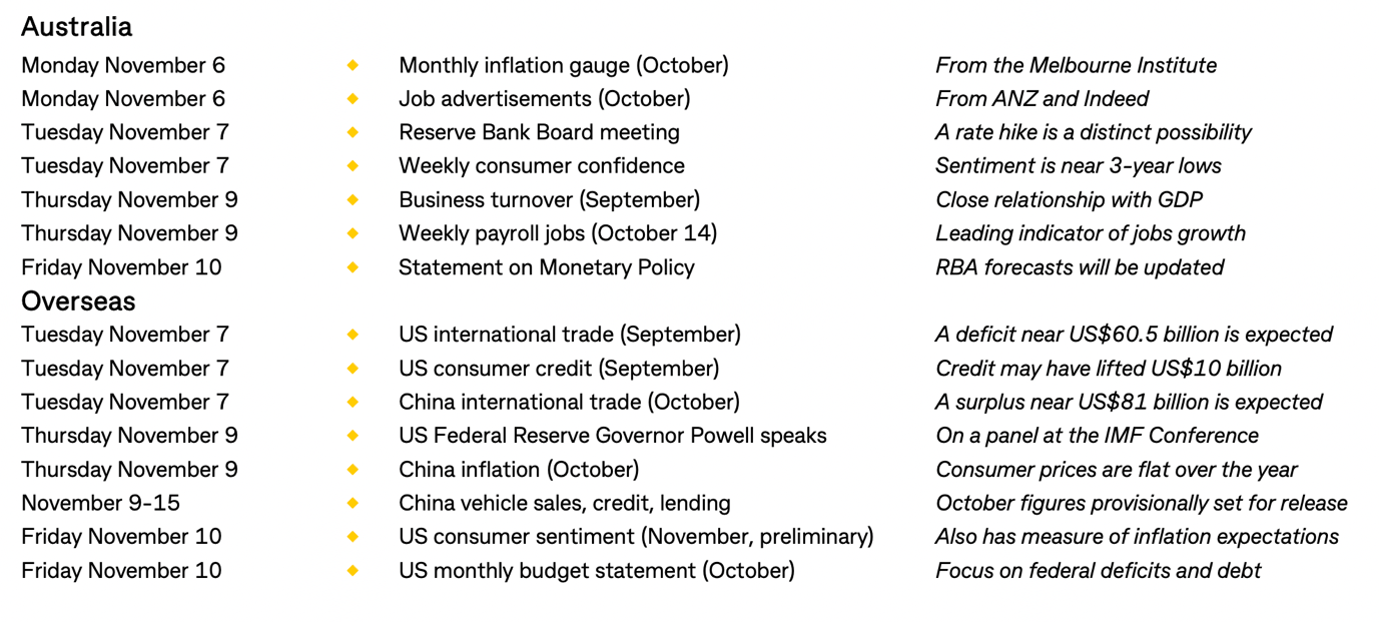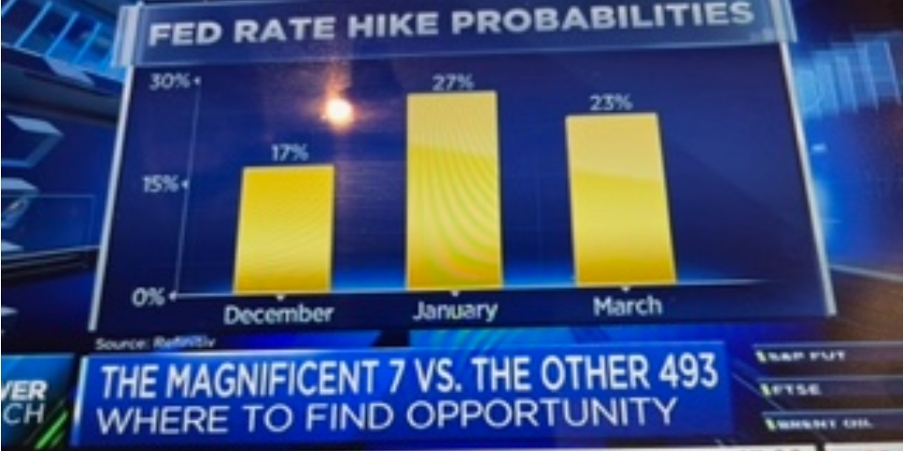
Like beautiful clockwork, US economic data has delivered to make the soothing words of the Fed’s Jerome Powell from Wednesday even more believable. And yep, again Wall Street lapped it up and our market is expected to open higher on Monday.
So, what was the good news?
Try a nice soft jobs report with only 150,000 jobs created in October, when economists tipped 170,000 and unemployment sneaked up to 3.9% from 3.8%. It shows the Fed’s interest rate policy is working, but it’s not screaming to be afraid that a recession is coming.
Adding to the positivity was a 4.7% increase in productivity for the third quarter and unit labour costs fell 0.8%, as average hourly earnings rose only 0.2%, when the expectations was for a 0.3% jump.
This is all good news and takes away the likelihood that we’ll see Wall Street do what it has been doing for most of 2023, that is going positive on economic data, implying the fight with inflation looked good, but then going negative on new less encouraging data for the Fed’s goal to get inflation down to 2%.
There is a material change in the outlook for US inflation and it’s convincingly down, which the Fed wanted to see. That’s why all three most-watched stock market indexes finished in positive territory on Friday. It’s like the scene from the movie, When Harry Met Sally – Michele Bullock wants what Jerome Powell is having: falling inflation and slowly rising unemployment. The only plus for us investors is that while we might face higher interest rates if you have a home loan, at least our stocks will play follow the leader with the Yanks.
Of course, there will still be a watch on US economic data, and it could take a couple of months of statistics before Wall Street gets really excited and committed to stocks other than the Magnificent Seven — Microsoft, Apple, Nvidia, Alphabet, Tesla, Amazon and Meta/Facebook. But the past few days have been a great sign for your resident optimist!
I think this from Michelle Cluver, portfolio strategist at Global X neatly sums up the current US market situation: “From an equity market perspective, this reading takes some of the pressure off inflation and interest rate concerns, while still reflecting a robust labour market that is adding jobs faster than the neutral rate of approximately 100K.” (CNBC)
This latter reference to a slowing job creation effort that’s not too aggressive hoses down recession worries. For 2023, there has been this economic ping pong game of fear where you had some players concerned about inflation being persistently too high, or at the other end of the table, investors worrying about recession.
This week was a ripper for those who were rooting for a gradual decline in inflation, with a good likelihood of a soft economic landing with no recession. Remember, last week the US saw annual economic growth come in at a robust 4.9% annualized rate for the last quarter, which was the fastest since the fourth quarter of 2021, when there was “we’re out of lockdown” pent up demand pushing big economic activity.
Right now, it looks like a Goldilocks scenario for the US economy — not too hot, not too cold but just right. Let’s hope it can be sustained for the sake of our portfolios.
Reinforcing this good news for stocks is the fact that bond yields have been on the slide this week, which dissipates another headwind for stocks going forward.
And the good news keeps coming, with AMP’s Shane Oliver telling us that around 80% of US S&P 500 companies have now reported September quarter earnings, with 81.6% coming in better than expected, which is above the norm of 76% and the strongest in two years.
With all the above, Goldman Sachs chief economist Jan Hatzius has gone public telling us he believes the Fed is done with rate rises, but he doesn’t expect rate cuts until the fourth quarter of 2024. Only a bigger drop in growth and a bigger spike in the jobless rate would bring these cuts in earlier.
To the local story and it was a great week at the office for stocks, with the S&P/ASX 200 up 3.12% or 211 beautiful points to 6978.2. Goodman Group had a good week, up 11.1% to $22.04. And so did Charter Hall, which put on 12.4% to $9.70. Meanwhile, CSL gained some love with a 6.06% rise for the week to $244, while Resmed gained 7.9% to $23.15.
Block, the parent of Afterpay, had a better-than-expected result and added over 25% on Friday and 28% for the week to finish at $81.18. Not surprisingly, ZIP went along for the ride jumping 17.2% for the week, while tech darling Xero rose 7.5% to $112.29. Another tech leader, Megaport, went up 8.5% to $10.15.
This might be a nice weekend to check out your overall portfolio — there should be some nice news.
What I Liked
- The Fed’s Jerome Powell and what he said and what he implied about interest rates in the US going forward.
- New housing lending rose by 0.6% a month in September, following a 2.4% increase in August, with
investors continuing to be the driver of housing lending growth. Owner‑occupier lending was flat in the month. - Building approvals fell by 4.6% for the month to 13,144 in September, with the level of approvals around decade lows. This is good for keeping the RBA on hold.
- Private sector house approvals fell by 4.6% to be 12.6% lower through the year and private multi‑unit dwellings fell by 5.1% to be 33.1% lower through the year!
- US labour market indicators continued to cool this week, which is good for US rates and Wall Street and then our market.
- US labour productivity rebounded 2.2% over the year to the September quarter, pushing growth in unit labour costs down to 1.9% year-on-year, which is consistent with the Fed’s 2% inflation target
- Eurozone GDP fell 0.1% in the September quarter. The good news is that CPI inflation has fallen to 2.9% year-on-year (from a peak last year over 10%).
What I didn’t like
- Dwelling prices rose by a strong 0.9% across the eight capital cities in October – the ninth consecutive monthly gain. This is bad for keeping the RBA on hold. Dwelling prices have now risen by 8.9% since their February trough!
- The pace of private sector credit growth accelerated in September, rising 0.5%, up from 0.4% in August, though the annual rate of credit growth continued to slow and now sits at 4.9% over the year.
- Retail trade rose by 0.9% in September, driven by a spike in immigration. This isn’t good for interest rates, with the CBA economics team saying “…retail sales rose at a solid pace in September, beating market estimates, suggesting that an interest rate hike could come as soon as next week”.
- After a brief stabilisation, most Chinese business condition PMI’s fell again in October, suggesting growth may have started to weaken again.
What Wall Street gives…
This year has been a tough year for local stock players, thanks to the ups and downs of data in the US. Wall Street has led us a less-than-merry dance this year. However, this week’s economic and Federal Reserve revelations look like they’ve taken us to a turning point for stocks and have set us up for the positive November and December that I’ve been predicting. Let’s hope geopolitical concerns from the Middle East, or Washington with their potential government shutdown, don’t ruin the return to optimism for Wall Street, for the sake of our portfolios and people’s lives!
The Week in Review
Switzer TV
- Boom Doom Zoom: 2nd November 2023
- SwitzerTV: 30th October 2023
- Meet legendary retailer Remo Giuffre and his unique book! – SwitzerTV Special
- Blue chip stocks versus punter plays – SwitzerTV Short
Switzer Report
- Here’s why Breville & Endeavour are worth adding to your portfolio watchlist
- “HOT” stock: Fortescue Metals Group (FMG)
- Questions of the Week
- Three quality non-emotional plays and two risky ones
- Have term deposit rates peaked?
- HOT stock: Coles (COL)
- 3 under-the-radar industrials
- Buy, Hold, Sell — What the Brokers Say
Switzer Daily
- What would you do if you won a million dollars?
- Here’s why the RBA should ignore all calls for a Cup Day rate rise
- Why I’m not worried about this fall in the stock market
- Ripper retail numbers will raise rates and immigrants will be blamed
- Why we’ll get the rate rise we don’t need
- Come October 2024 Sir Keir Starmer will be the British Prime Minister – by Malcolm Mackerras
The Week Ahead

Top Stocks — how they fared.

Chart of the Week
Sorry for the crappy chart but I quickly took off CNBC using my iPhone. I was excited to see the predictions for US rate rises going out to March and you can see why stocks have been on the rise since Thursday.

Stocks Shorted

ASIC releases data daily on the major short positions in the market. These are the stocks with the highest proportion of their ordinary shares that have been sold short, which could suggest investors are expecting the price to come down. The table shows how this has changed compared to the week before
Quote of the Week
“Stifel says the S&P 500 will keep climbing ‘wall of worry’ to hit 4,400…That 4,400 level would mark a gain of 3.8% from Wednesday’s close and 14.6% from the end of 2022.” (Stifel’s Barry Bannister on CNBC)
Disclaimer
Important: This content has been prepared without taking account of the objectives, financial situation or needs of any particular individual. It does not constitute formal advice. Consider the appropriateness of the information in regards to your circumstances.

